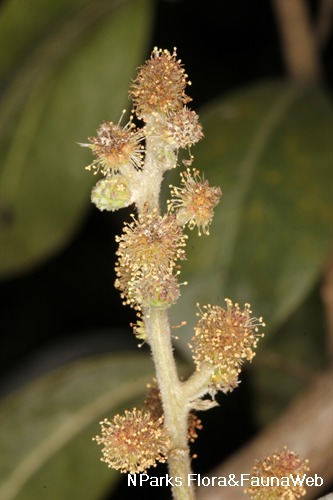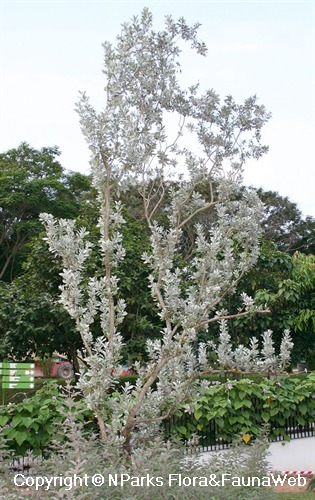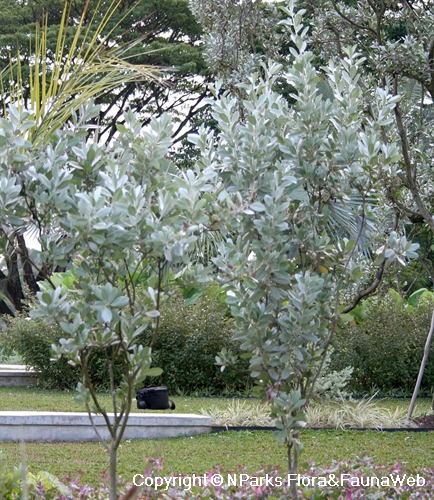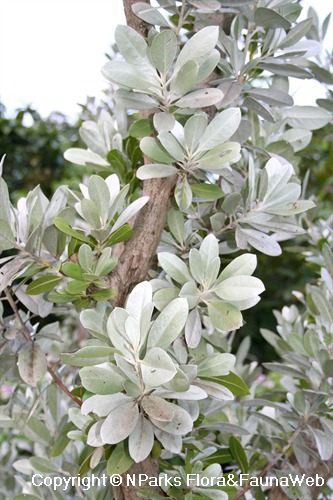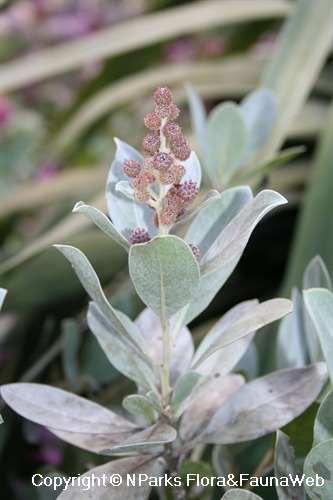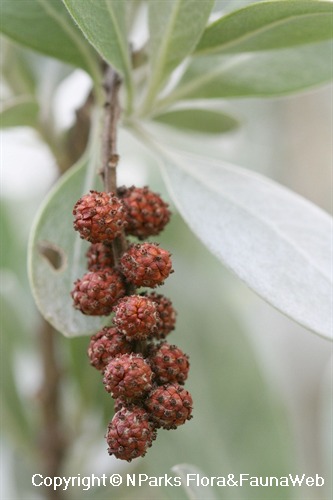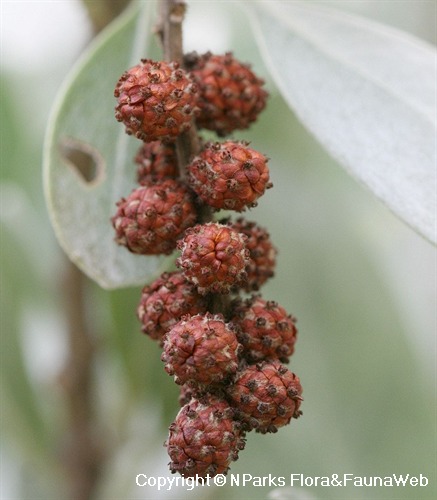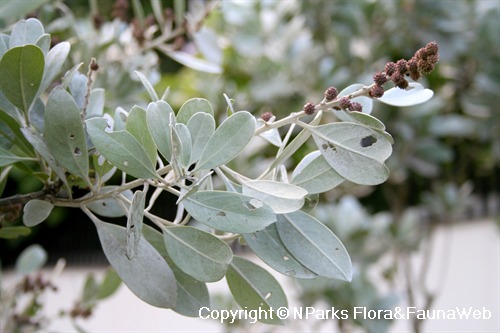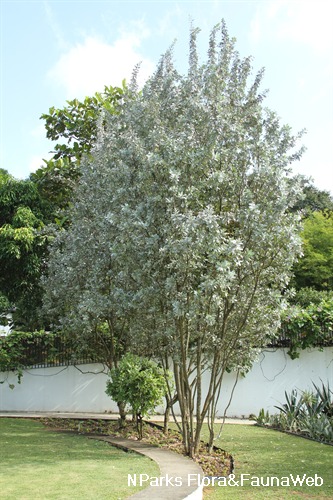
Back
Conocarpus erectus var. sericeus Fors ex DC.
| Family Name: | Combretaceae |
| Common Name: | Silver Buttonwood, Silver-leaf Buttonwood, Button Mangrove, Grey Mangrove, False Mangrove |
Name
Classifications and Characteristics
| Plant Division | Angiosperms (Flowering Seed Plants) (Dicotyledon) |
|---|---|
| Plant Growth Form | Tree, Shrub |
| Lifespan (in Singapore) | Perennial |
| Mode of Nutrition | Autotrophic |
| Plant Shape | Vase, Weeping / Pendulous, Open |
| Maximum Height | 15 m |
| Maximum Plant Spread / Crown Width | 6 m |
Biogeography
| Native Distribution | Tropical Americas (Florida, Mexico, Honduras, Bahamas, Jamaica), Tropical West Africa |
|---|---|
| Native Habitat | Terrestrial (Coastal Forest) |
| Preferred Climate Zone | Tropical |
| Local Conservation Status | Non-native (Horticultural / Cultivated Only) |
Description and Ethnobotany
| Growth Form | It is a multi-trunked tree, or shrub with low spreading branches. |
|---|---|
| Foliage | Its alternate, stalked leaves are oblong to lanceolate in shape, densely-covered by silky hairs and appear silver in colour, 5-10 cm long. |
| Flowers | Its flowers are inconspicuous, greenish purple-white, free-blooming. |
| Fruit | Its fruits are aggregate fruits, reddish-brown in colour, small, resembling cone-like buttons. |
| Others - Plant Morphology | Can be planted singly as specimen tree in silver-themed gardens, or grown close together as informal or clipped hedge. Also suitable as bonsai. Drought and salt-tolerant, suitable for coastal or beachfront planting. Coastal trees tend to grow contorted trunks. Plants located far inland may be affected by sooty mould caused by sucking insects. Wood once used as high-quality charcoal in Florida, especially for smoking fish and meat dishes. Corky bark harvested commercially for high tannin content. |
| Habitat | It grows in coastal swamps of (along the edges of salt flats, rocklands, fresh and brackish marshes) in South Florida. |
| Cultivation | It can be propagated by seeds or stem-cuttings. |
| Etymology | Greek kono, cone, Greek karpos, fruit, referring to the cone-like fruits; Latin erectus, upright; Latin sericeus, silky, silky-hairy, referring to the silky hairs that cover the surfaces of the leaves. |
| Ethnobotanical Uses | Timber & Products: Wood was once an important source of firewood and charcoal in Florida. Sometimes used in cabinet-making. Bark is high in tannin, can be harvested commercially. |
Landscaping Features
| Landscaping | It is suitable for planting along roadsides, parks and gardens for its attractive silvery foliage, and its tolerance to hot and windy conditions. |
|---|---|
| Desirable Plant Features | Ornamental Foliage, Ornamental Fruits, Ornamental Trunk |
| Landscape Uses | Coastal, Suitable for Bonsai, Suitable for Roadsides, Flowerbed / Border, Hedge / Screening, Container Planting, General, Parks & Gardens, Small Gardens |
| Thematic Landscaping | Silver Garden, Moonlight Garden |
| Usage Hazard - Cons | Low Crown / Clearance |
| Plant & Rootzone Preference or Tolerance Remarks | Tolerates occasional wet soils. |
Fauna, Pollination and Dispersal
| Seed or Spore Dispersal | Abiotic (Water, Explosive Dehiscence) |
|---|
Plant Care and Propagation
| Light Preference | Full Sun |
|---|---|
| Water Preference | Moderate Water, Little Water |
| Plant Growth Rate | Moderate |
| Rootzone Tolerance | Drought Tolerant, Fertile Loamy Soils, Well-Drained Soils, Waterlogged Soils (Drains Site), Saline Soils / Salt Spray, Acidic (low pH) Soils, Alkaline high pH Soils |
| Maintenance Requirements | Moderate |
| Pruning | Branches tend to droop with age, require pruning for pedestrian or vehicular clearance. Can be trained to grow with multiple or single trunk. |
| Diseases | No known serious pests or diseases. Sucking insects may cause sooty mold on inland trees. |
| Propagation Method | Stem Cutting, Air-Layering, Seed |
| Propagation Method Remarks | Seeds reportedly sterile, or not true to parent plant. |
| Planting Distance | 6 m |
Foliar
| Foliage Retention | Evergreen |
|---|---|
| Mature Foliage Colour(s) | Silver / Grey |
| Mature Foliage Texture(s) | Smooth, Velvety / Furry / Tomentose, Thick |
| Foliar Modification | Salt Excreting |
| Foliar Type | Simple / Unifoliate |
| Foliar Arrangement Along Stem | Alternate |
| Foliar Attachment to Stem | Petiolate |
| Foliar Shape(s) | Non-Palm Foliage (Lanceolate, Oblong) |
| Foliar Venation | Pinnate / Net |
| Foliar Margin | Entire |
| Typical Foliar Area | Microphyll ( 2.25cm2 - 20.25 cm2 ) |
| Leaf Area Index (LAI) for Green Plot Ratio | 3.0 (Tree - Intermediate Canopy) |
Non - Foliar and Storage
| Trunk Type (Non Palm) | Woody |
|---|---|
| Bark Colour(s) | Dark brown |
| Mature Bark Texture | Fissured, Scaly |
| Stem Type & Modification | Woody |
| Root Type | Underground (Tap Root, Fibrous Root) |
Floral (Angiosperm)
| Flower & Plant Sexuality | Bisexual Flowers |
| Flower Colour(s) | Green, Purple, White |
|---|---|
| Flower Grouping | Cluster / Inflorescence |
| Flower Location | Axillary |
| Flower Size - Remarks | Small, inconspicuous |
| Inflorescence Type | Panicle |
| Flowering Period | Free-Flowering |
| Flowering Opening Time | Time-Independent |
| Flower Lifespan on Plant | Several Days |
| Flowering Habit | Polycarpic |
Fruit, Seed and Spore
| Mature Fruit Colour(s) | Brown, Red |
|---|---|
| Fruit Classification | Aggregate Fruit (Syncarp) |
| Fruit Type | Dehiscent Dry Fruit |
Image Repository
Others
| Master ID | 21753 |
|---|---|
| Species ID | 3372 |
| Flora Disclaimer | The information in this website has been compiled from reliable sources, such as reference works on medicinal plants. It is not a substitute for medical advice or treatment and NParks does not purport to provide any medical advice. Readers should always consult his/her physician before using or consuming a plant for medicinal purposes. |

